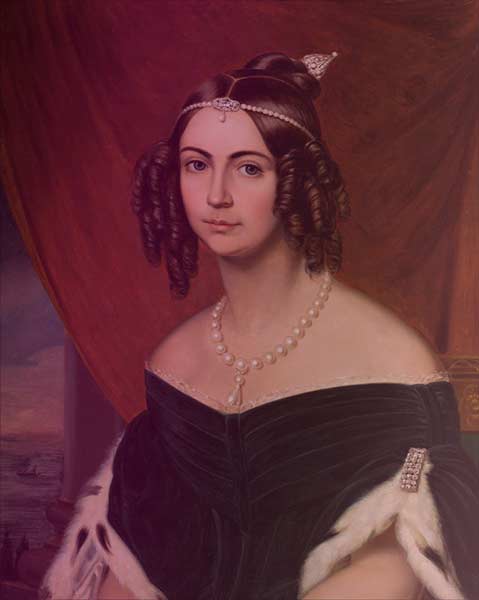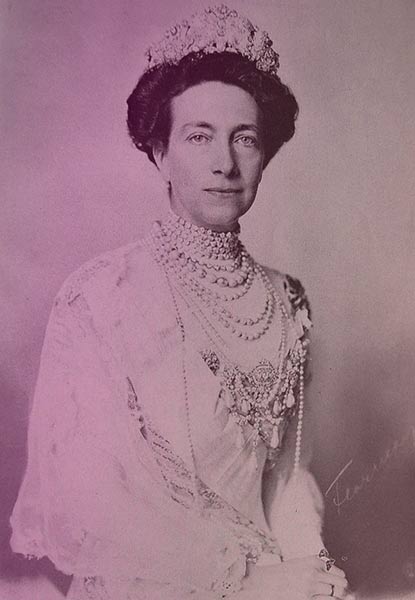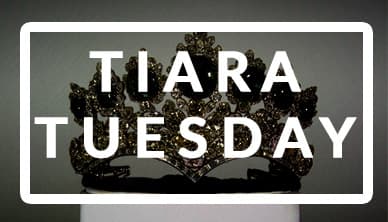Share this Post
The Braganza tiara was made for Empress Amélie of Brazil in 1829, as a wedding present from her husband, Emperor Pedro I. Brazil used to be a Portuguese colony, and the surname of the Portuguese royal family is Braganza (Bragança in Portuguese), hence this tiara’s name. You might also remember Charles II’s queen, Catherine of Braganza – she was a Portuguese princess.
Made of diamonds mounted in gold and silver, this tiara is reputedly a bitch to wear. It’s about 5 inches tall and weighs anywhere from 2.2 pounds to 6.6 pounds, depending on who you ask. Queen Louise of Sweden said it gave her headaches; Queen Silvia of Sweden says it moves when you wear it and it’s hard on the neck. If it were me, I’d just carry around a bit of medicinal Absolut and keep on truckin’. These are both queens of Sweden, after all. They’re at the source. What good is royal prerogative if not to commandeer some…er…pain medication? Here it is on Queen Silvia:
So Does It Belong to Portugal or Sweden?
Okay, so when Napoleon told Europe “all your base are belong to us,” Europe’s reigning royal families had a big problem. Stay and fight or cut and run? The Braganzas chose to run. After all, they owned Brazil, so if you were in the right mindset, it was like an extended beach vacation. In 1807, King Dom João VI and his family booked their one-way ticket to Rio de Janeiro. They liked it so much they stayed past Napoleon’s eventual defeat, ruling Portugal by proxy.
But a revolt in Portugal in 1820 forced the king’s hand and he had to go take care of business or risk losing the whole damn country. He left his son, Pedro, in charge of Brazil.
But here’s the thing. Much like ebola, revolutionary fervor is contagious. Brazil decided to revolt, too.
Much like ebola, revolutionary fervor is contagious.
Contrary to expectations, Pedro joined the revolt against dear old dad and helped declare Brazil’s independence in 1822, accepting the offer to become the new country’s emperor, of course.
Incest Is Best
When dear old dad died in 1826, Pedro found himself Emperor of Brazil and King of Portugal. But the people weren’t having any of it, not after all the trouble they took to separate themselves from Portugal in the first place. So Pedro came up with a plan: abdicate the throne of Portugal in favor of his daughter, Maria, if and only if two conditions were met: (a) the people of Portugal accept a liberal constitution, and (b) Maria agreed to marry her uncle (Pedro’s brother) Miguel.
And now it’s time for an interjection: WHAT THE FUCK, DUDE. HERE YOU ARE, BEING ALL LIBERAL AND SELF-AWARE IN YOUR NEW KINGDOM OF BRAZIL, AND THEN YOU MANDATE THIS REPUGNANT SHIT?
Anyway, this caused a boatload of problems because Miguel was really more interested in taking the country over for himself. Pedro’s conditions led to several more coups and abdications and a general political shitstorm that took eight years to get under control.
The moral of the story? Don’t make your kid marry your brother.
But What Happened to the Tiara?
Pedro’s first wife, Maria Leopoldina, died in 1826. For his second wife, he chose Amélie of Leuchtenberg, a daughter of Eugene de Beauharnais and granddaughter of Josephine, Napoleon’s first wife. This was weird, because Pedro’s first wife was the sister of Napoleon’s second wife. I mean, seriously. It’s like these people didn’t even own copies of their own family trees.
Also, “chose” is probably the wrong word. Eight other ladies had already turned him down because of his notorious womanizing, the recent revolution, and the fact that Brazil was the ghetto as far as normal European society was concerned.
Eight other ladies had already turned him down because of his notorious womanizing, the recent revolution, and the fact that Brazil was the ghetto as far as normal European society was concerned.
Pedro knew he had to cough up the goods to thank Amélie for marrying him. He bought back Maria Leopoldina’s diamonds from her children, who had inherited them when she died, and used them in this tiara – Amélie’s wedding present.
Unfortunately, the political shitstorm referenced above caught up with Pedro and he abdicated in 1831 to focus on helping his daughter keep the crown of Portugal. Amélie and Pedro returned to Portugal, where she remained for many years after Pedro’s death. She died in 1873 and her tiaras passed to her sister, Queen Josephine of Sweden. Here she is in her gorgeous prime, in a painting from about 1837:

Who Owns This Tiara Today?
It still belongs to the royal family of Sweden. Queen Josephine of Sweden wore it, as did her successors: Queen Sophia, Queen Victoria (shown below), and Crown Princess Louise, who wore it to the coronation of Britain’s George VI in 1937.

The present queen, Silvia, has worn this tiara numerous times, including state dinners and official portraits. Most recently, she wore it to her daughter Victoria’s wedding in 2010. The tiara has only left the country twice, once for the coronation of George VI and once when Silvia wore it on a state visit to Denmark (although she has publicly stated the tiara will never leave the country again). It’s said that she loves the tiara because it reminds her of her mother, who is Brazilian.
How I’d Wear It
This sucker is tall. You really need a horizontal hair poof to balance it out. I’d have to sleep on curlers overnight to have a shot in hell at wearing this well. But I love it. I love the juxtaposition of all those diamonds with the seemingly low-key motifs of leaves and flowers.
I’d wear this one to the theater to annoy the crap out of whoever sits behind me. It’s so tall there’s no way they’d be able to see over me, which would probably force them to move, which means no one would be kicking the back of my seat all the way through the show. Total score.
Bonus Mexican Connection
Amélie and Pedro had one daughter, Maria Amelia. She was engaged to Maximilian of Austria until her early death from tuberculosis before the marriage could take place. Yes, the same Maximilian of Austria who let the French make him Emperor of Mexico, a venture which ended with another Latin American revolution and his death at the hands of a firing squad.
Note to European monarchs: Don’t fuck with Latin America. It always ends badly for you.
That’s the Braganza tiara!
Want to suggest a tiara? Drop its name or a photo link into the comments. I’ll do my best to find something interesting in its history for a future Tiara Tuesday.
Image credits
Amélie: Friedrich Dürck, public domain via Wikimedia Commons
Victoria: Gösta Florman, public domain via Wikimedia Commons

Love Royalty and Tiaras?
You might like my other site, The Girl in the Tiara. I created it to write about amazing royal women and their tiaras. It’s like Drunk History meets The Crown.

Tiara Tuesday Archives
Visit the archives to read about more royal shenanigans. And by shenanigans, I mean war, revolution, betrayal, lust, murder, diamonds, and Princess Stéphanie’s chafing dish.
Share this Post
